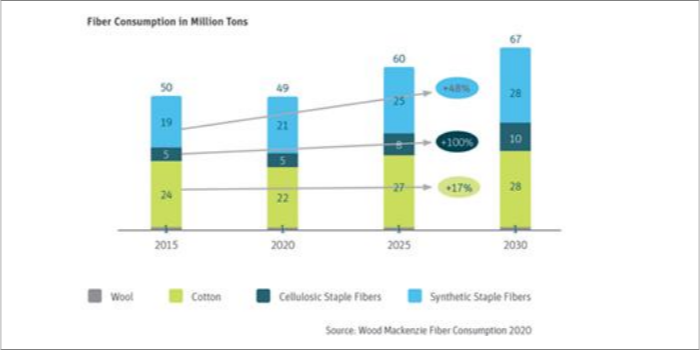
Unlocking the potential of man-made fibres with ring spinning
Fibre consumption is on the rise, and man-made fibres (MMF) play an important role in this. Blends containing various fibre materials are particularly popular and are found in an increasing number of applications. The ring spinning machine G 38 of Rieter offers unique solutions for processing MMF and blends.
As population growth and prosperity increase, so does the consumption of fibres across the globe. While this holds true for all staple fibres, the use of man-made fibres such as cellulosic staple fibres and synthetic staple fibres is growing particularly quickly. The consumption of cellulosic staple fibres is expected to double to 10 million tons by 2030 while the consumption of synthetic staple fibres is expected to grow by 48% to 28 million tons compared to 2015 (Figure 1). Rieter addresses these market needs and continuously develops innovative technology components and solutions for MMF and blends for all end spinning processes.
MMF package for ring spinning
Synthetic fibres – usually polyester – and their blends with cotton are commonly processed on ring spinning machines. Different blends with cellulosic fibres are another popular application. In general, ring spinning is very flexible compared to other spinning processes and reacts less sensitively to fibre finish deposits which is a common challenge when processing MMF. Nevertheless, there are some technology elements on the ring spinning machine that have been specially developed for the characteristics of MMF and special settings that should be considered. One of these technology elements is the bottom roller with a diameter of 30 mm. It helps to reduce the build-up of fibre lapping for fine fibres like MMF.
Thanks to an additional drive unit for the middle bottom roller, positioned in the middle of the machine, Rieter can offer long ring spinning machines also for MMF: The G 37 machine with semi-electronic drafting system drive can be equipped with up to 1 632 spindles and the G 38 machine with a fully electronic drafting system drive with up to 1 824 spindles.
High tenacity requires special solutions
Due to their high tenacity, synthetic fibres cause higher part wear during processing. This can be mitigated by installing separators with reinforced front edges. These edges help to protect the separators from the fibre ends in the event of an ends down and increase the life cycle of the parts significantly. The high tenacity of synthetic fibres also poses challenges in terms of reliable detachment during the cop change procedure. If the detachment is unsuccessful, this can result in dragged yarn and a series of ends down, which affects yarn quality and efficiency. For this reason, a special SERVOgrip with a knife has been developed that reliably cuts off the yarn during the doffing process and prevents yarn breaks during start-up (Figure 2).



I am extremely impressed with your writing skills and also with the layout on your blog. Is this a paid theme or did you customize it yourself? Either way keep up the nice quality writing, it’s rare to see a great blog like this one today..
… [Trackback]
[…] Find More here to that Topic: indiantextilejournal.com/unlocking-the-potential-of-man-made-fibres-with-ring-spinning/ […]
… [Trackback]
[…] Info to that Topic: indiantextilejournal.com/unlocking-the-potential-of-man-made-fibres-with-ring-spinning/ […]
… [Trackback]
[…] Read More Info here to that Topic: indiantextilejournal.com/unlocking-the-potential-of-man-made-fibres-with-ring-spinning/ […]
… [Trackback]
[…] Read More Information here to that Topic: indiantextilejournal.com/unlocking-the-potential-of-man-made-fibres-with-ring-spinning/ […]